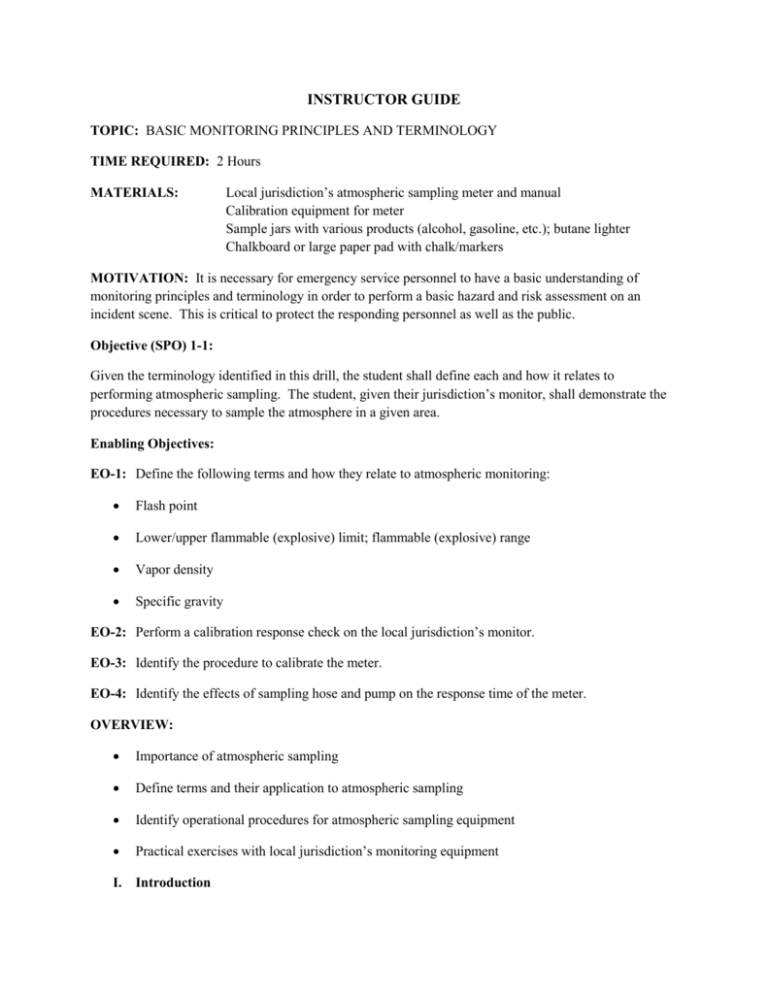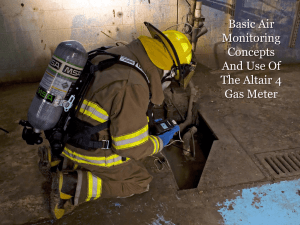June 2008 Instructor`s Guide (MS Word format)
advertisement

INSTRUCTOR GUIDE TOPIC: BASIC MONITORING PRINCIPLES AND TERMINOLOGY TIME REQUIRED: 2 Hours MATERIALS: Local jurisdiction’s atmospheric sampling meter and manual Calibration equipment for meter Sample jars with various products (alcohol, gasoline, etc.); butane lighter Chalkboard or large paper pad with chalk/markers MOTIVATION: It is necessary for emergency service personnel to have a basic understanding of monitoring principles and terminology in order to perform a basic hazard and risk assessment on an incident scene. This is critical to protect the responding personnel as well as the public. Objective (SPO) 1-1: Given the terminology identified in this drill, the student shall define each and how it relates to performing atmospheric sampling. The student, given their jurisdiction’s monitor, shall demonstrate the procedures necessary to sample the atmosphere in a given area. Enabling Objectives: EO-1: Define the following terms and how they relate to atmospheric monitoring: Flash point Lower/upper flammable (explosive) limit; flammable (explosive) range Vapor density Specific gravity EO-2: Perform a calibration response check on the local jurisdiction’s monitor. EO-3: Identify the procedure to calibrate the meter. EO-4: Identify the effects of sampling hose and pump on the response time of the meter. OVERVIEW: Importance of atmospheric sampling Define terms and their application to atmospheric sampling Identify operational procedures for atmospheric sampling equipment Practical exercises with local jurisdiction’s monitoring equipment I. Introduction A. The proper use of atmospheric sampling equipment is important to protect our personnel from the hazards present on emergency scenes. The body’s senses are not able to detect the presence of some of these hazards because they may have no odor or may desensitize them. B. Functions of monitoring 1. Hazard and risk assessment a. Oxygen deficiency/enrichment b. Flammable materials c. Toxic gases/vapors 2. Determine the Personal Protective Equipment (PPE) necessary a. Respiratory protection—SCBA vs. Air Purifying Respirator b. Thermal protection c. Chemical protective clothing 3. Identification of materials present 4. Establishment of hazard zones—migration of hazardous gases II. Terminology A. Flash point 1. The temperature at which a liquid gives off enough flammable vapors in the presence of an external ignition to flash and go out—does not sustain combustion 2. Identify materials with low flash points—gasoline, alcohol 3. Identify materials with high flash points—diesel fuel, kerosene 4. The form of the material is also of importance—diesel fuel is atomized when fuel injector puts it into cylinder and causes it to ignite B. Boiling point 1. The temperature at which a liquid boils—water into steam 2. The temperature where the vapor pressure of a liquid exceeds the pressure on it a. If pressure is increased on the liquid, the boiling point is raised b. If the pressure is decreased on the liquid, the boiling point is lowered C. Vapor density 1. The weight of a gas or vapor in comparison to air at the same temperature 2. Air has a vapor density of 1 a. Gases with a vapor density less than 1 will rise (if they are at a low temperature, they may remain low until the temperatures equalize b. Gases with a vapor density greater than 1 will sink and stay low 3. Importance to monitoring a. Gases may be stratified within an area i. Sample at least three levels—high, mid-level, low or every 4 feet of depth b. Migration of gases when they come out of their container—where are they going? D. Specific gravity 1. Comparison of a liquid or solid to the weight of water 2. Water has a specific gravity of 1 a. Liquids with a specific gravity less than 1 will float b. Liquids with a specific gravity greater than 1 will sink E. Flammable (explosive) range and limits 1. Lower flammable/explosive limit (LFL/LEL) a. Minimum concentration of a gas in air that will ignite in the presence of an external ignition source b. If the mixture is below the LFL/LEL, it is too lean to burn 2. Upper flammable/explosive limit (UFL/UEL) a. Maximum concentration of a gas in air that will ignite in the presence of an external ignition source b. If the mixture is above the UFL/UEL, it is too rich to burn 3. Flammable/explosive range a. Consists of the concentrations between the lower and upper flammable/explosive limits b. Varies by product i. Gasoline—1.4-7.6% ii. Methane—5-15% iii. Carbon monoxide—12.5-74% iv. Ammonia—16-25% v. Acetylene—3-100% c. Combustible dusts (flour, sugar, etc.) i. Action level is determined by visibility—if 5 feet or less, considered hazardous ii. If there is an explosion, multiple explosions are likely and may be larger than the first III. Atmospheric Sampling A. Proper assessment of the atmosphere—perform in proper order 1. Corrosives (if suspected, must use pH paper to determine presence and protect meter) 2. Oxygen content a. Normal atmospheric concentration is approximately 21% (depending on monitor, may be 20.8, 20.9, or 21%) b. Considered oxygen deficient if 19.5% or below i. If lower than normal, will affect the flammability readings ii. If necessary to enter, personnel must use atmosphere supplied respirator—SCBA or SAR (Supplied Air Respirator) iii. Consideration needs to be given to what displaced the oxygen c. Considered oxygen enriched if above 23.5% i. If higher than normal, will affect the flammability readings ii. Will support combustion and increase flammability of materials present d. Local jurisdiction may establish more stringent parameters 3. Flammability a. Measured in a percentage of the LFL or LEL b. Action level is 10% LEL—atmosphere is treated as flammable at this point or above c. Based upon a specific calibration gas, usually methane or pentane 4. Toxic materials a. Need to be more product specific because their presence is evaluated in PPM (Parts per Million) b. Most monitors purchased by Fire Departments are 3 or 4 gas with those sensors as listed below (toxics may be different based upon jurisdictional need) i. Oxygen ii. Flammability iii. Carbon monoxide iv. Hydrogen sulfide IV. Practical exercise with local jurisdiction’s monitor A. Obtain the monitor and operator’s manual B. Review and follow procedures listed in manual 1. Turn unit on and perform a fresh air setup—need to be in clean air a. Zeroes unit to atmosphere b. If contaminants present, unit will not successfully perform setup 2. If unit will not perform fresh air setup with clean air, it may be necessary to enter calibration—listed later 3. Perform battery check—if not sufficient, replace/recharge battery 4. Perform calibration response check a. Obtain calibration kit and calibration cylinder—make sure the test gas is in date (check for expiration date—hydrogen sulfide has a stability of 1 year) b. Place calibration cap on monitor or utilize pump on meter c. Place regulator assembly on cylinder and attach hose to meter and regulator d. Allow time for monitor to respond and stabilize readings e. Check to see if the readings are within acceptable limits—usually listed on cylinder or in operator’s manual f. If monitor has peak readings feature, clear the peaks 5. Perform calibration on meter a. Enter into calibration sequence as outlined in operator’s manual b. Utilize calibration gas to set readings on monitor to correspond with those on cylinder 6. Make notation in log for meter of use/calibration C. Attach sample hose and demonstrate the effect of the length of tubing on response time 1. Obstruct end of sample hose and make sure pump stalls/alarms 2. Rule of thumb is at least 1 second per foot 3. Check operator’s manual 4. Check at least 3 levels of area allowing monitor to respond D. Identify situations where calibration response check should be performed after the initial response check 1. Meter readings have gone off scale—above 100% LEL (most newer monitors will latch off-scale) 2. Meter has been dropped 3. Meter has been affected by radio frequency interference (RFI)—radio transmitted with monitor too close; gives an alarm. E. Sampling exercises 1. Obtain samples—alcohol, gasoline, butane lighter 2. Expose monitor to sample—diffusion or pump 3. If utilizing sample hose, note length of hose and time it takes to obtain response and full reading 4. When finished exercises, perform a calibration response check on the monitor— calibrate if necessary V. Review A. Importance of atmospheric sampling B. Definitions and their relevance to atmospheric sampling C. Operational procedures for monitoring equipment D. Practical exercises with local jurisdiction’s monitoring equipment Objective (SPO) 1-1: Given the terminology identified in this drill, the student shall define each and how it relates to performing atmospheric sampling. The student, given their jurisdiction’s monitor, shall demonstrate the procedures necessary to sample the atmosphere in a given area.








